#banh cuon tay ho
Text
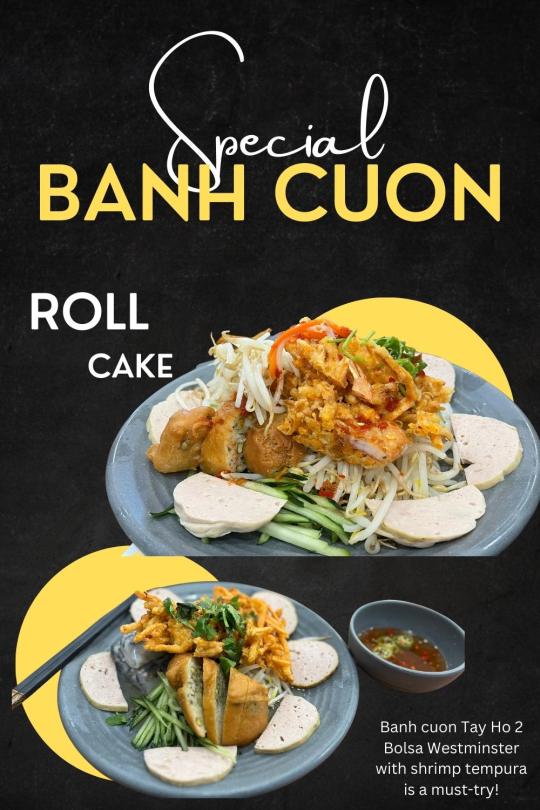

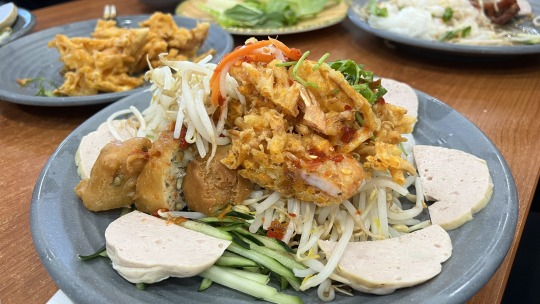
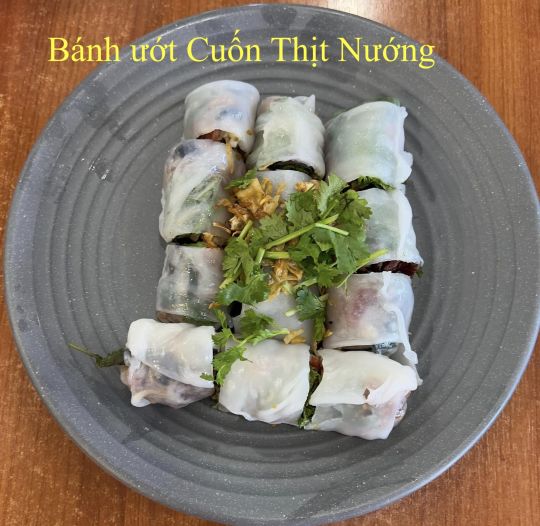
Banh cuon Tay Ho 2 Bolsa Westminster with shrimp tempura is a must-try!
Bánh Cuốn Tây Hồ 2 in Westminster, CA 92683 - Banh cuon Bolsa Ave : Banh Cuon (Roll Cake), a traditional Vietnamese dish, is a delicious and versatile delicacy that can be incorporated into a healthy, balanced diet. This article will explore the various ways in which you can enjoy Banh Cuon while staying mindful of your nutritional needs. We will delve into its origin, nutritional benefits, and the importance of choosing the right ingredients. Furthermore, we will provide insights into healthy cooking techniques and portion control, along with creative serving suggestions. Whether you are a fan of this light and delicate rice noodle dish or new to its flavors, this article will guide you in embracing Banh Cuon as a wholesome addition to your meal repertoire.
Banh Cuon Bolsa Westminster
Add : 9242 Bolsa Ave F, Westminster, CA 92683
Website : https://banhcuontayho2westminster.com/
#food#delicious#food porn#banh cuon tay ho#banh cuon#roll cake#vietnamese#vietnam#vietnamese food#vietnamese cuisine
2 notes
·
View notes
Text
Tay Ho, 529 E Valley Blvd, Ste 1188, San Gabriel, CA 91776
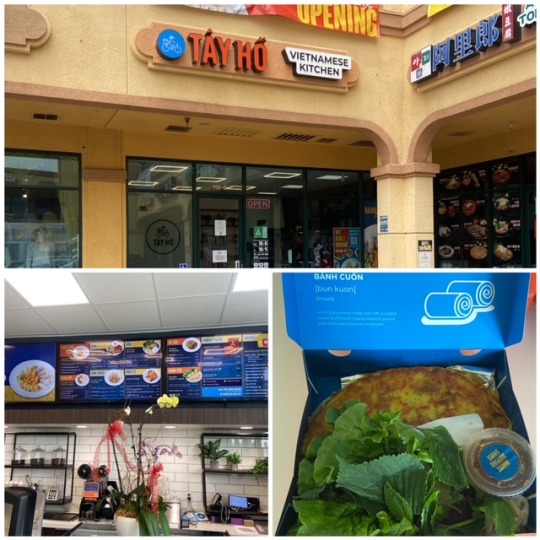
Tay Ho, the well-known Vietnamese hole in the wall in Orange County, opened a modern, hip looking location in San Gabriel. It’s set up for takeout – with tables and chairs. There’s a self-service order kiosk and you can also order online through their website or app.
The menu includes variations of banh cuon, banh uot, rice plates, bun, appetizers, garlic noodles, banh xeo, and drinks. They were out of a few things – not sure if it was a supply chain issue. I saw they had yogurt labels in the display case but no yogurt. I wanted the soy milk on the menu but they didn’t have any.
Everything comes in a very nice takeout box with a custom takeout bag. They spent a lot on packaging and branding. I could do without the fancy packaging but the pricing wasn’t bad. I’ll reuse the bag.
Banh xeo (crispy crepe) with mushroom and tofu filling ($11) and spicy house dipping sauce: It comes with cucumber, pickled carrots and daikon, fresh lettuce, herbs and a dipping sauce. I was told it would take 15-20 minutes since the crepe takes that long to cook. Worth the wait. The golden crepe was pretty oily but super crispy. It was filled with bean sprouts, chewy mushroom strips, and tofu. I wrapped the crepe in the lettuce leaves with the fresh herbs and pickled veggies, dipped it in the house dipping sauce (nuoc cham) – divine! Lots of flavors and textures, fresh and filling.
Order online. They also have their own app where you can place orders and earn points.
4.5 out of 5 stars.
By Lolia S.
0 notes
Photo

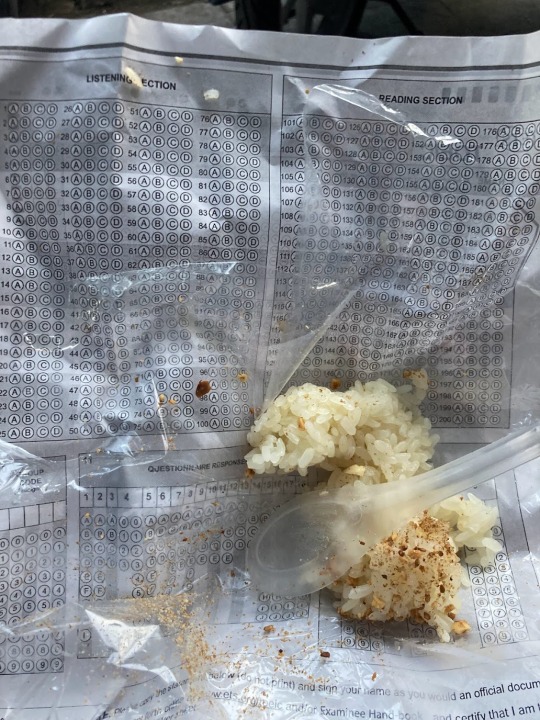


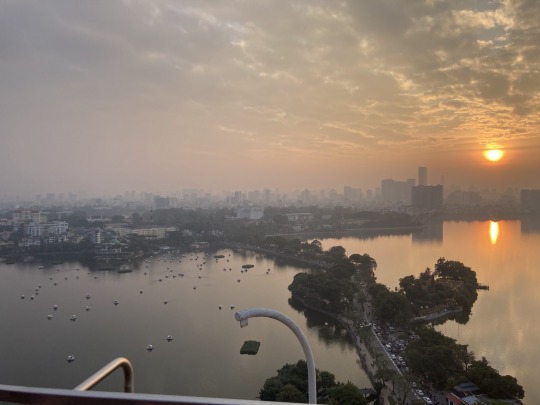

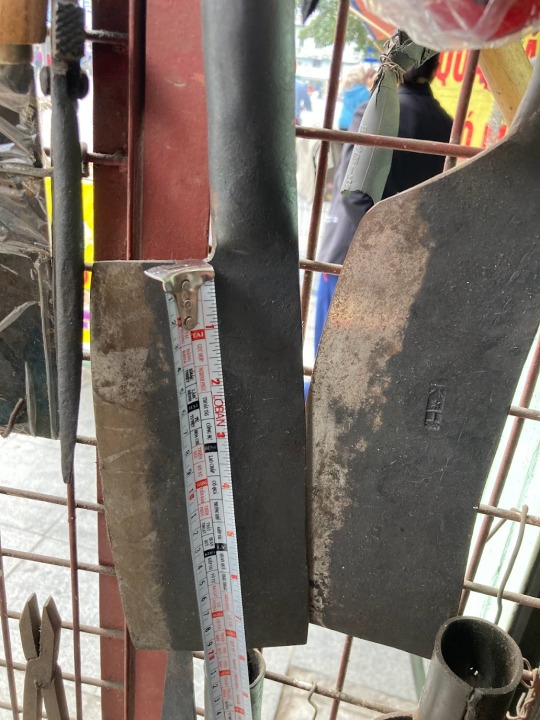
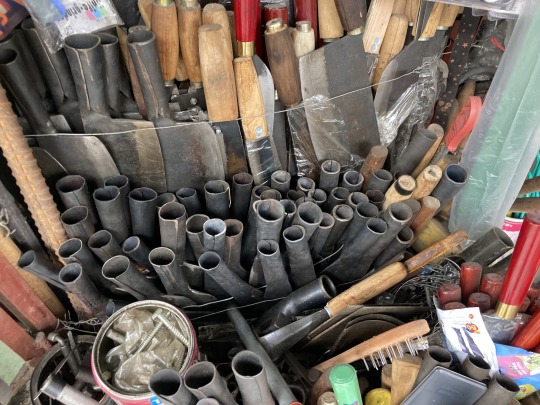
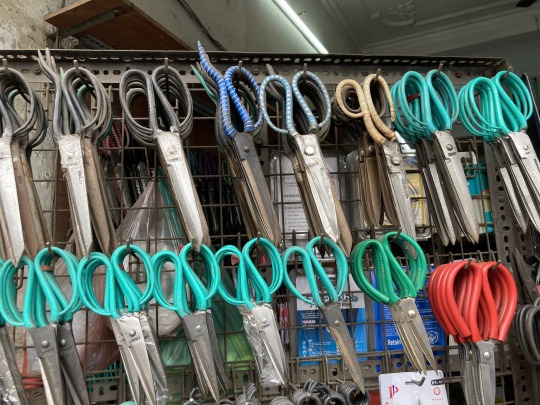
After arriving in Hanoi, I met up with my mom (Pam) and aunt (Skye). We promptly headed out to get a couple special Vietnamese breakfast foods: Xoi and Banh Cuon.
We spend the next couple days exploring Hanoi. We visted the Ho Chi Minh mausoleum, but it was closed that day for New Years so we couldn’t go inside. We also went to the nearby botanical garden and walked near Ho Tay (West Lake).
Everyone in the group knew they wanted to bring back some Vietnamese knives either for themselves or as gifts for friends. We went to the knife street in Hanoi (where P. Nguyễn Khuyến crosses the train track) to check the selection so we had an idea of what we wanted to buy later. They had many knives, cleavers, scissors, and other tools. We took some measurements and looked over things but didn’t buy any yet.
1 note
·
View note
Photo

Grand Opening Day at Sunny Plaza for this Vietnamese Fast Food Chain with 15 locations nationwide! (at Banh Cuon Tay Ho) https://www.instagram.com/p/CY24XZELsbX/?utm_medium=tumblr
0 notes
Photo
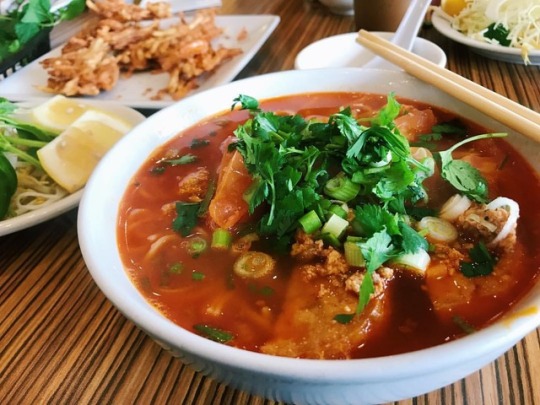
Sometimes you just want a taste of home. The #bunrieu from #tâyhồ 👌🏼 . . . #vietnamesefood #asianfood #noodles #tomatosoup #meatballs #vermicelli #crab #shrimp #nomchecklist #food #foodie #foodporn #treatyoself #caliving #foodpics #westcoast #westminster #viettown (at Banh Cuon Tay Ho)
#crab#foodie#asianfood#vermicelli#meatballs#viettown#food#shrimp#nomchecklist#westminster#vietnamesefood#foodporn#tâyhồ#noodles#caliving#tomatosoup#foodpics#bunrieu#westcoast#treatyoself
2 notes
·
View notes
Photo
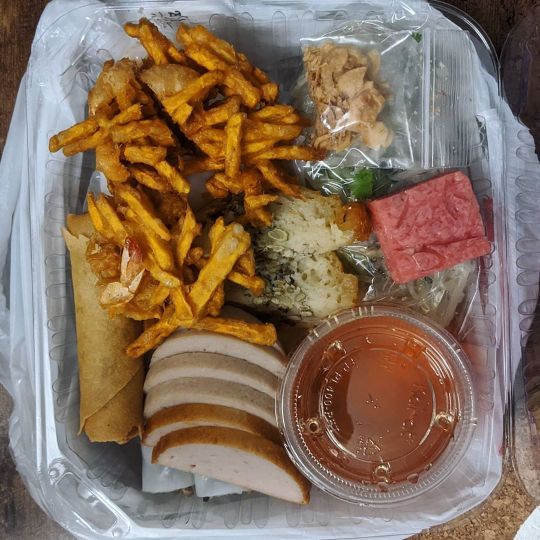
When the after work walk turns into banh cuon for dinner. 😂 (at Tay Ho Restaurant) https://www.instagram.com/p/CE5zGJRjpnI5knsXpWP8spNsIjwf9-qrkzfiG40/?igshid=1j9dfasdc1lgp
0 notes
Photo

Banh cuon for breakfast 😍 (at Banh Cuon Tay Ho) https://www.instagram.com/p/B3P0odFHZjr/?igshid=hlhp68olbwsh
0 notes
Text
Vietnam, Part 2
Hitting the road again, or the skies I should say (although we did one bus ride during our trip – more about that later…), we touched down in Da Nang, specifically to visit The Museum of Cham Sculpture, a museum that is not to be missed if you’re in Vietnam.
I forgot all my deities since I stopped doing yoga (such as Ganesha and Shiva, and how one guy got that elephant head, and why Shiva is wearing that snake around their neck – and smiling about it), so it’s good to do a little reading about them before you go to help you understand more about the artifacts in this museum. We took an 8am flight out of Ho Chi Minh airport, landing about an hour later, and taking a taxi right from the airport to the museum, which is only 3km away (I’ve given some tips at the end of the post about using taxis in Vietnam, that are worth noting), so it was easy to get there and spend the morning looking at the remarkable sculptures and friezes, many dating back to the 4th century.
I have the lowest museum attention span in the world, and two hours in this museum was just the right about of time to take it all in. Then I grabbed a Grab to take us to Hoi An, where we spent the next two nights. The old town of Hoi An is a UNESCO World Heritage Site and its traditional architecture is well-preserved, although not overly so. It still has a bit of funk, in spite of quite a few tourists (including us) roaming the streets.
Someone told me Hoi An is the most touristed town in Vietnam and it’d be hard to disagree. At night, the historic old town is jumping with people strolling by, and shops selling stuff, as well as locals offering everything from boat rides and fruit, to silk scarves (the town is known for its silk) and leather sandals. People also come to Hoi An to have suits and clothing made for them, and you’ll find several streets lined with custom tailor shops. Someone told me that if you bring a picture of what you like; a suit, a dress, or a shirt, they’ll make it for you, and have it ready in a day or two. I grew up wearing ties and jackets to school every day, so it takes a pretty compelling reason (or event) to get me into a suit, so I passed, but could have used a few more linen shirts since the ones I brought were splattered with Pho and dragon fruit stains.
Outside of the old town, we found more interesting things than in the old town, like the jumble of housewares being sold on a sidewalk, below, and spa treatments at White Rose Spa. We learned back in Ho Chi Minh City that massages and facials are very inexpensive in Vietnam, and mostly very good, so we’d indulged with our friends there, and now, here. (Note that it’s customary to tip if you had a good treatment.)
In Hoi An, we had a very good meal at Vy’s Market (the lime leaf chicken skewers were particularly good, as was the tofu skin salad), which someone online wrote was “sanitized” street food. It may have been, but we liked it all the same. Very fresh ingredients, nice servers, and tasty. Cao Lau Bale Well (45/3 Train Hung Dao) was recommended by several people (not locals) and while we found the place interesting, the Cao Lau noodles weren’t all that compelling. It was, however, charming, located off a side street in what was probably part of their home. They were also really nice, which made it…fine.
Another meal was at Nu. A sweet little place where the steamed pork buns were good, as was the chili ice cream we had for dessert. You won’t be the only English-speaking people dining there, but we liked it. There’s also a night market with an indoor eating area for street food, which I’d check out if I went back. If you want a taste of Egg Coffee, I had one at Passion Fruit coffee that even my skeptical partner liked. (I tried to compare it to sabayon, but he wasn’t having any of that.)
We stayed at the Vinh Hung Riverside hotel located on the river, not far from the old town, but far enough away so you were a decent distance from the fray. The staff was unfailingly polite and helpful and we had a nice room on the river, although I’d recommend perhaps staying in a room that’s not on the ground floor. I didn’t want to sleep with the door open so we shut everything and turned on the AC. The button on the machine was so bright that it was like a spotlight over us, in the room, which made it a bit difficult to sleep. It wasn’t really hot enough to warrant the AC, but we used it instead of keeping the door open. (Unfortunately, the unit was high on the wall and there wasn’t anything to block the light with, but I just discovered these, and am thinking of traveling with them because so many hotels have appliances and switches with really bright lights. Can people really sleep with all those lights flickering and glowing in the dark?) But we liked the hotel, which had a nice pool, and the breakfast offered a variety of Vietnamese foods and fruits. I gorged on rambutans, mangoes, and passion fruits.
We then took the 2-hour bus to Hue, which ended up taking a little more than 4 1/2 hours. The bus had funny, sort-of lie back seats, which looked appealing when I first saw them, but anyone taller than 5 feet (or who has never done yoga) might feel a bit squished after a while. (Another spoiler: You couldn’t sit upright in the seat, even if you wanted to.) While the bus had pillows, which Romain and some others grabbed for propping themselves up, the driver bellowed at anyone who took one, so they sheepishly put them back. I was okay lying halfway down for an afternoon, although some people were going all the way to Hanoi, and I’m sure they will need a few massage treatments to uncoil them once they arrive.
I hate to post the obligatory “I’m in paradise” shot, especially when so many of you (or us, which now includes me) are back in the cold. But this was a pretty beautiful spot in Hue.
It was our hotel, the Pilgrimage Village. It was located a little out-of-town, but the hotel had a shuttle and cabs were inexpensive (about $3 -4) to take you anywhere you wanted to go. So it wasn’t a problem going back and forth.
I was especially interested in going to the Dong Ba market in Hue. There was a lot to see there, and when our taxi driver dropped us off, he took Romain’s shoulder bag off his shoulder, and wrapped the handles around his neck, letting him know the keep his eyes on his things.
The market is pretty much an all-out assault of foods, spices, people, stuff, cookware, raw meat, kids, hats, seafood, fabric, jewelry, eyeglasses, bins of rice, tropical fruits, and more. Once you’re inside, you’ve pretty much go to go all-in. Even though the electricity seemed to be off in the market, we surged forward with everyone. If you stand still, within seconds, someone will slide past, through the narrow aisles with tables heaped with stuff on either side of you, and while it wasn’t at all dangerous, it’d be pretty easy to lose a billfold if you weren’t mindful of it.
Some people have said that the sellers were very aggressive here, although we didn’t find that to be too much of the case. Like other markets in Vietnam (except for the ones we went to in Ho Chi Minh City, if you stopped to look at anything, or even glance at it, the vendor will do their best to engage you and negotiate a price, even if you don’t really want it. It’s not my preferred way to shop, but that’s the way it’s done. Which was probably better for me anyway, as I didn’t have as so much to lug home. Although those colorful jars of pickled vegetables were certainly tempting!
We did track down the well-known Bun bo Hue (beef soup) stand, which is in the “street food” section of the market. (There’s a story about how to find it here.) We were a little underwhelmed, as the people next to us seemed to be. Maybe it was an off day, but if you look at the Bun bo Hue we had later that evening, two pics down, I’ll let you decide which soup looks better to you.
If you do go to the market in Hue, I would hire a guide, or take a tour of the market with someone who knows it well. It’s pretty overwhelming and there’s a lot of see, and taste, which isn’t so easy to do on your own. It’s definitely one of the great markets I’ve been to in the world, and worth exploring. But there was so much I wanted to know more about, it would have been nice to have someone navigate for us, and explain what things were, like these orange fruits (or vegetables?)
We ate well that night at Tai Phu where the Bun bo Hue (below) was more to my liking.
We also had some good Banh cuon (rice paper rolls) at Tai Phu, and Romain liked his Bun thit (vermicelli noodles with chicken) but the dish of the house seemed to be the pork skewers (nem lui), which came in a plentiful portion with green mango slices, noodles, and herbs, to roll in rice paper.
[A reader who lives in Hue was kind enough to chime in with some local spots for Bun bo Hue – thanks smallhue! – suggesting Bún Cam at 45 Le Loi and Bún Mụ Roi at 14 Nguyen Che Dieu, that she advised getting to before 8am for the best selection of “options,” as she called them. Our hotel had breakfast on a dock under a thatched roof, with unlimited Vietnamese coffees, so I wasn’t leaving there.]
If you eat at Tai Phu, be sure to arrive in the area early and walk around the streets, where an open-air market takes place. It’s pretty laid back, and like all the markets in Vietnam, you want to cry at how beautiful all the fruits and vegetables are, stacked, lined, and piled up. I think it’s called the Ben Ngu market.
The most beautiful meal we had in Vietnam was at a place whose name I forgot (I know…right?) It had a little open-air area within the restaurant, and from the outside, you’d never know such a charming place existed. When I remember the name, I’ll update the post.
However beautiful the meal was, it was a challenge to eat. Absolutely no offense to the restaurant, but the flavors were very, very strong, and hard to describe. I think, like Vegemite, natto, and blue cheese, some things don’t translate outside their culture. I can’t describe it but I felt bad leaving most of it behind. I also wasn’t feeling so great that day, so it was hard to power through a meal of distinctive flavors. But I will say, the others in the restaurant were eating everything and enjoying it, so it was definitely our tastes, and didn’t reflect on the quality (and the beauty) of the food.
We liked eating at HANH, in Hue, the night we arrived, which was recommended by a woman at our hotel. We started with tiny bowls holding steamed rice cakes with fresh shrimp and bits of crunchy pork rinds, which you pry from the bowls with a spoon and eat with fish sauce. I ordered a bottle of what was called “local rice wine” in English on the menu, and out came a 500ml (2 cup) bottle of “Men vodka.”
When I posted a picture on Instagram, one reader noted it was “just awful stuff” and another said, “terrible…unpleasant.” I asked the server if I could exchange it for shochu, which was so strong, I think I lost a few layers of enamel on my teeth trying to, and a couple of layers of my stomach lining, as I didn’t want to be impolite and leave a lot behind. I drank what I could, then chalked it up to a “lesson learned”! Perhaps the kitchen staff enjoyed the rest after their shift.
After returning to Ho Chi Minh City, we didn’t get to go back to Spice, which we really like the first night of our arrival, because it was Tet (New Year’s), which most of the city shuts down, including restaurants.
But we did eat at Quan Bui Garden (in District 2), where you can also buy beautiful contemporary Vietnamese pottery (I brought six plates back), and Restaurant 13, where we liked the beef and onions cooked in vinegar, which you wrap in rice paper rolls at the table, as well as the little crisp rice cakes, with shrimp and scallions, known as Banh Khot (above), which you wrap in leaves and eat.
At Com Nieu Sai Gon there were several families there celebrating Tet, and having a good time. We had jellied pork, crispy fish on rice (above), Caramelized clay Pot pork, and grilled prawns. (The menu had “fake dog meat” on it, which we didn’t order.) We kept hearing plates shatter, while people cheered, and weren’t sure what was happening. But the restaurant bakes rice until a crisp coating forms on the bottoms in small earthenware bowls. The rice is “presented” by smashing the bowl. It’s called Com Dap, and here’s a video of it:
I also met up with pals Marge Perry and David Bonom, who just happened to also be traveling through Vietnam at the same time, for Banh Mi sandwiches from Banh Mie Huynh Hoa, eating them at a local beer garden, whose men’s room was definitely rated R (or maybe X, depending on your sensibilities). I did take photos but worried that they would violate Instagram’s guidelines (and trust me, even after a few decades of living in San Francisco, I thought nothing would shock me), so didn’t publish them anywhere. But David and I are still recovering from it, and even Marge, who I insisted go into the men’s room for a look.
But I don’t want to leave you on that note, as Vietnam was wonderful. Some readers asked me how it was to travel through the country and I thought it was pretty great. On the whole, it was fairly easy to travel there and people were friendly and helpful. The food was very good, it’s not expensive, and the country is small enough so that you can visit several places if you’re there for ten days or so. It’s a country that’s in transition (they’ve gone through a lot), and has some challenges, but it was one of the most exciting places I’ve ever visited and next year, we’re planning to go back.
Here are some tips and suggestions for traveling in Vietnam:
1. Change money when you can. It’s not as easy to change money in Vietnam as it is elsewhere. While there are banks, locals don’t use them, instead preferring to change money elsewhere, if they can. Citibank and HSBC have ATMs which work with western credit cards; some local bank machines don’t work with U.S.-based cards. Citibank and HSBC ATMs are not everywhere, though, so use them when you find them.
Many places take credit cards in Vietnam, but some places don’t. Taxis have credit card machines but over half the time, the driver told me they weren’t functioning. (One held up a broken wire, to show me.) So have cash available. Also be sure to call your bank before you go, to let them know you’ll be traveling in Vietnam.
2. Carry tissues or napkins. Some restaurants supply them, others have very small squares of wispy-thin paper to use, and others give you a pre-moistened towelette. The food can be saucy (and restrooms don’t always have towels or tissues) so I was glad I have little tissue packets on hand. You should also carry toilet tissue as restrooms don’t always have it.
3. Drink a lot of (bottled) water. The tap water should not be consumed and it’s easy to get dehydrated due to the heat. I was felled for a day with a mild fever, which maybe was attributed to not getting enough water. (Or perhaps something I ate.) While there are drugstores in Vietnam, they are more like counters with a pharmacist and pills are sold individually. Although we didn’t need them, some travelers find they need Immodium or a similar product, which traveling, so I recommend bringing a box along rather than trying to find a box when you’re desperate.
Similarly, you can get sunscreen in Vietnam, but it’s not as widely available as it may be at home. I recommend bringing a bottle or two, especially if you’re planning any beach time.
4. When eating out, especially at the markets or street food stalls, go to places that are crowded with locals. They won’t return to places that don’t have good hygiene. Use common sense when eating at stalls; look at how clean the surrounding area is, how the food is kept, how the food is prepared, and even the condition of the tables, chairs, and dining area. As someone who’s worked in a number of restaurant kitchens, a messy, disorganized place is not the sign of a diligent cook or owner.
At Pho places on the street, I buried the herbs in the hot soup if I thought they may have been washed with non-filtered water. If you’re unsure about the chopsticks, leave them in the boiling-hot soup a short while before using them. The Vietnamese enjoy cold drinks with ice and I drank plenty of drinks with ice, and didn’t have any issues. Most ice is purchased and made with filtered water. But if you have any doubts, skip the ice.
5. If taking a cab, always take a cab with a meter. Our friends who live there said that Vinasun and Mailinh (the green cabs) are two that have meters in them, and I always looked for one of those cabs. In our experience, it’s better to let them use the meter than agree on a fixed fare in advance. (The one time I did that, the ride was 30% more than the metered fare.) Taxis are very inexpensive and the fare from Ho Chi Minh City to or from the airport was around 150,000 VND ($7).
At places like airports, you’ll find nicely dressed guys with badges who will “guide” you from the cab line to a taxi, then tell you what the fare is. Those guys work for specific cab companies and I found it better to ignore them (in spite of their repeated, and sometimes relentless, pleadings…) and just get in a cab that has a meter.
6. Grab is an Uber-like service that works the same way, via an app, which you can download before you go, but you’ll have to enter your credit card information while you’re in Vietnam. The service works like Uber. Note that you can order a car, or ride on the back of a scooter. (They provide a helmet for you if you choose the scooter option.) I used them a couple of times, including when we were swarmed by very aggressive cab drivers going into a museum (one even followed me around the museum), so I had a Grab driver meet me on the way out, and took his phone number down for future rides.
7. The currency conversion is a little complicated, at least to my non-mathematical brain. At the time of this writing, $1 = 23,000 Vietnamese Dong. There are no coins in Vietnam (yay!), but it’s easy to get confused. (And note that prices on menus and in shops will often be listed as just “230” when the price is 230,000.) I used AppBox Pro for currency conversions.
8. While it’s nice to learn the local language, Vietnamese is a challenge. I’m going to take some basic lessons next time I go, but Google translate was very helpful when I wanted specific information and couldn’t communicate. Some people do speak English, but most cab drivers (etc) don’t, so take a screenshot of an address or write it down (or have someone write it down for you), which helps, especially directions to the hotel. (Note that hotels that have names in English often have a different name in Vietnamese. Ask your hotel in advance to send you that information and print it out to bring with you, for the driver.) I often shared a screenshot with a cab driver of my destination on Google Maps, which they easily understood, too. Restaurants often have menus with pictures, which helps when ordering.
9. People in Vietnam were quite friendly. I only got scolded once for taking a pic and most people were fine with it. When in doubt, ask first, but most people were surprised that I even asked, a few even posing.
10. SIM cards are super cheap – and my internet was at least four times faster than it is in Paris. (I wanted to bring it back with me!) If you have an unlocked phone, you can pick up a SIM card for a pittance and have internet access while you’re traveling. I got a SIM card at Mobifone and I think I paid the equivalent of $10 for an enormous amount of data. I went to one of their offices and the clerk was super-helpful and she took care of everything, making sure it worked on my phone before I left. Be sure to have a copy of your passport when purchasing a SIM card. (If you go to a currency conversion place, they’ll want to see it, too.)
11. If you travel within the country you’ll likely take VietJet. (The other option are long-distance buses.) Airfares are reasonable but note that they have a very, very restrictive carry-on allowance of only 7kg and if you go over, the supplement is $100. You can buy tickets that have more generous luggage allowance, but our friends who bought our tickets bought the least-expensive, which are how most Vietnamese people seem to fly (carry on only). Every flight we took that left in the afternoon or early evening was delayed for a couple of hours, so don’t schedule things too tight. We also weren’t able to check in online for any of our flights, but the process at the airport isn’t too difficult and the staff at the airports were pretty efficient.
12. As for what to wear, I recommend dark-colored clothes as the food is a bit messy to eat, especially the soups. I ended up wearing the one dark, short sleeve linen shirt I’d brought most of the time, which was perfect, and I was miffed at myself for bringing light-colored items. It’s normal to wear sandals in Vietnam so bring a pair or two that are already broken in. Many people wear simple, non-fancy rubber sandals, which you can purchase inexpensively in Vietnam. I wasn’t anywhere where I needed to wear shoes, and once I took mine off, I didn’t put them back on until we headed to the airport for the plane home.
Depending on where you’re going, and when, you might want to pack a light sweater and a rain jacket. We only needed summer-weight clothes, but other places get chillier, depending on the latitude and season. Check the local forecast and pack accordingly. Unless you’re going to a formal event, you shouldn’t need any dressy clothes. If you plan to visit religious sites, such as temples and pagodas, men are expected to wear long pants and no tank tops; women should have something to cover bare shoulders, and you may not be admitted to certain places if wearing a short skirt or wear something with a low neckline.
13. If you want to ride a scooter, technically you are supposed to have a Vietnamese driver’s license. Some say that you can use an international driver’s license, but my friends who live there (who have Vietnamese ones) said that wasn’t the case. I rode on the back of my friend’s scooter for two weeks and it was a great way to get around. Some hotel rent bikes and scooters and I would use them, as they’re more familiar with the rules.
14. If you’re interested in cooking Vietnamese food, Andrea Nguyen’s cookbooks are great sources of recipes for Vietnamese dishes. This write-up of 25 Must-Eat Dishes in Saigon is helpful for identifying certain dishes, and where to find them in Ho Chi Minh City and these articles on best Hoi An restaurants and street food have some enticing addresses, too.
15. Lastly, to go to Vietnam, if you are traveling with an American passport, you’ll need a visa. If you search online, you’ll find a lot of websites which are fake visa processing centers. We used Vietnam Visa Center, which was recommended by Lonely Planet, and it worked well. (A friend who goes to Vietnam regularly uses this company.) We paid the extra small fee to have “fast track” service, and have someone meet us upon our arrival at the airport, and take us through. (Update: Several readers noted that Vietnam does have its own website for processing visas electronically. You can also obtain one from a Vietnamese embassy, too.)
For more on my trip to Vietnam, check out my Instagram Stories from Vietnam archived Here and Here, with videos and geo-tagged addresses.
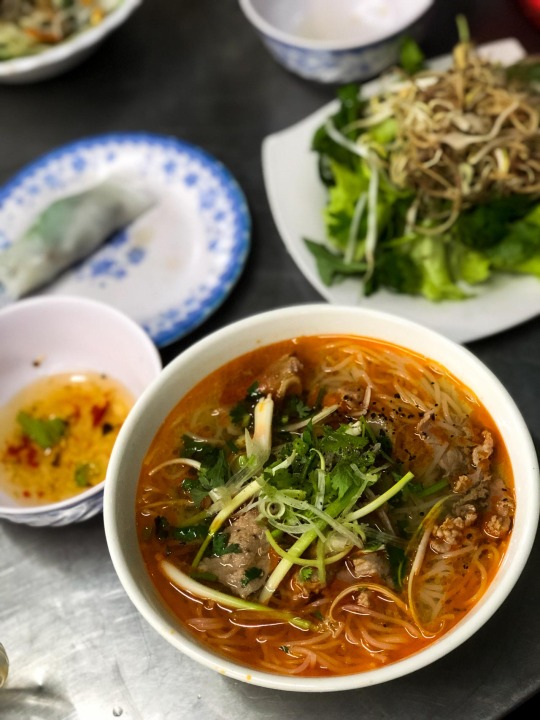

Source: https://www.davidlebovitz.com/vietnam-part-2-hue-da-nang-hoi-an-phu-quoc-travel/
0 notes
Photo

Banh cuon Tay ho 4. Lots of sauce (at Banh Cuon Tay Ho) https://www.instagram.com/p/BsZbysEA0AG/?utm_source=ig_tumblr_share&igshid=1bnivit55ehv0
0 notes
Text
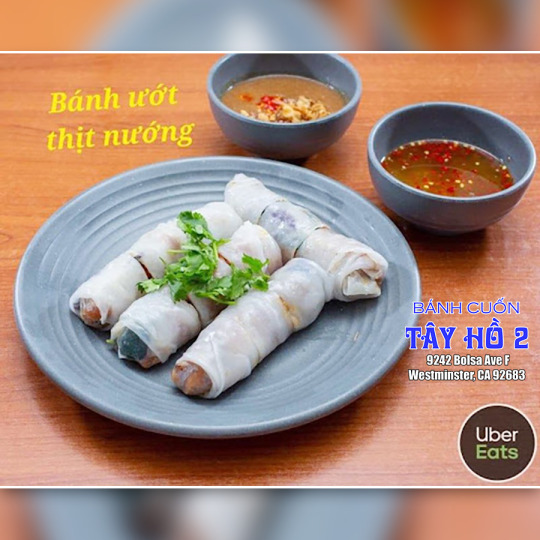
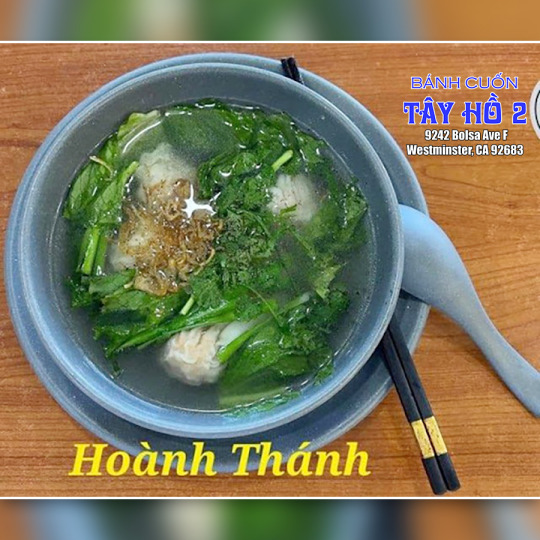


You shouldn't leave without trying our new dishes 😉😉
Banh Cuon Tay Ho 2 in Westminster, CA 92683 | Bolsa Ave
→ banhcuontayho2westminster.com
Quiet, relaxing ambiance and delicate tastes are what you are looking for in a Vietnamese experience. Then come to our restaurant in Westminster, CA 92683, and enjoy the unique dining experience.
Our menu offers an extensive selection of fresh quality meats, seafood, and vegetables for your dining experience. Banh Cuon Tay Ho 2 is a full-service restaurant that features a variety of dishes such as Noodles, Roll Cake, and Rice made only with the freshest ingredients.
0 notes
Text
Top 10 mercati migliori in Vietnam
I mercati sono tra i migliori posti in Vietnam per i viaggiatori che desiderano sperimentare la vita quotidiana della sua popolazione locale. Attivo già alle 03:00, troverai una serie di persone che cercano la frutta, la verdura, i frutti di mare e la carne più freschi. I mercati del Vietnam sono anche ottimi per assaggiare una vasta gamma di specialità locali a prezzi convenienti, in quanto sono spesso dotati di una corte dedicata al cibo circondata da bancarelle di cibo.
Foto: Luxury Travel Vietnam
Mentre la maggior parte dei mercati in Vietnam sono in funzione da centinaia di anni, ce ne sono diversi (soprattutto quelli situati nelle città) che ora sono orientati verso i turisti, con bancarelle che vendono artigianato, souvenir e prodotti alimentari preconfezionati. Mentre i beni qui vengono venduti a prezzi relativamente bassi, puoi comunque esercitare le tue abilità di contrattazione per ottenere affari migliori. Continua a leggere per la nostra pratica guida sui mercati locali più popolari del Vietnam.
1. Il mercato centrale della città delle lanterne – Hoi An.
Il mercato centrale di Hoi An in questa antica città dichiarata dall’UNESCO offre un’autentica esperienza di shopping per i viaggiatori in Vietnam. Situato lungo la riva del fiume Thu Bon, il mercato è pieno di gente e turisti che contrattano acquistando frutta fresca, verdura, spezie, artigianato e cibo per la strada. Il momento migliore per visitare è la mattina presto, poiché è quando i pescatori locali lasciano il loro pescato al mercato centrale di Hoi An, dove sarete accolti da un’atmosfera vivace di venditori di mercato e acquirenti locali che negoziano con fervore il miglior pesce. C’è anche una sezione nel mercato specializzata in seta e tessuti asiatici, con sarti esperti che offrono servizi su misura economici.
Orari di apertura: tutti i giorni dalle 07:00 alle 20:00.
Locazione: Le strade di Nguyen Hue e Tran Phu, Hoi An.
Foto: Luxury Travel Vietnam
2. Il mercato di Han – la città di Danang.
Il mercato Han è un’attrazione di rilievo a Da Nang, avendo servito la popolazione locale dalla colonizzazione francese all’inizio del XX secolo. Situato nel grande incrocio di via di Tran Phu, via di Bach Dang, via di Hung Vuong e via di Tran Hung Dao, i visitatori possono trovare centinaia di bancarelle che vendono praticamente tutto, dai prodotti locali e chicchi di caffè a magliette, gioielli e accessori. Durante la tua visita, assicurati di fare scorta di frutta tropicale fresca (banane, mango, durian e albero di pane) e di prodotti alimentari speciali di Da Nang (pasta di peperoncino preconfezionato, aglio dell’isola di Ly Son, cracker di riso e calamari secchi).
Orari di apertura: tutti i giorni dalle 05:00 alle 19:00.
Locazione: 119, via di Tran Phu, distretto di Hau Chai, Da Nang.
Foto: Travelling Planner – Flickr
3. Il mercato notturno del fine settimana di Hanoi.
Situato sul bordo settentrionale del centro storico, il mercato notturno del fine settimana di Hanoi si estende dalla via di Hang Dao verso il confine del mercato di Dong Xuan. L’attrazione principale di questo vivace mercato sono le infinite file di venditori di cibo che offrono cibo di strada vietnamita esotico. In occasioni speciali, come la festa di metà autunno, puoi anche assistere a spettacoli musicali tradizionali vietnamiti come Ca Tru, Xam e Quan Ho. Il mercato notturno del fine settimana di Hanoi è consigliato se stai cercando di acquistare souvenir, assicurati di contrattare duramente; è possibile ottenere circa il 75% di sconto sul primo prezzo offerto. La maggior parte delle bancarelle vendono articoli abbastanza simili, quindi puoi passare facilmente a quello successivo se il prezzo finale non è di tuo gradimento.
Orari di apertura: venerdì – domenica 20:00 – 23:00.
Locazione: Hang Dao Street, Hoan Kiem, Hanoi.
Foto: Mr. Logic – Flickr
4. Il mercato di Dong Ba della città romantica Hue.
Il mercato di Dong Ba è il più antico del suo genere nella città di Hue dell’UNESCO, dove la gente del posto frequenta tutto il giorno per acquistare articoli necessari per la propria casa, abbigliamento e prodotti freschi a prezzi convenienti. Occupando un grande edificio lungo la riva settentrionale del fiume dei Profumi, il mercato di Dong Ba è anche un ottimo posto per la colazione, poiché puoi gustare una vasta gamma di autentici piatti vietnamiti come pho, banh khoai (torta di dolce potato fritta) e involtini primavera freschi.
Orari di apertura: tutti i giorni dalle 03:00 alle 20:00.
Locazione: Via di Tran Hung Dao, Hue.
Foto: Zingnews
CONTATTACI
5. Il mercato dei fiori della capitale – Quang Ba.
Il mercato dei fiori di Quang Ba nel quartiere Tay Ho di Hanoi apre già alle 02:00, dove puoi trovare file di fiori colorati provenienti dai villaggi locali Dong Anh, Soc Son, Me Linh, Dalat e Nhat Tan. Il mercato è particolarmente frequentato durante il capo d’anno del Vietnam, con gente del posto ben vestita in ciclomotori che passano attraverso le navate strette. Margherite, fiori di ciliegio, rose, orchidee e girasoli sono venduti a prezzi relativamente convenienti, che possono essere acquistati separatamente o disposti in mazzi di fiori. Che tu sia un appassionato di fiori o un mattiniero estremamente mattiniero, il mercato dei fiori di Quang Ba è una destinazione da visitare quando sei ad Hanoi … non dimenticare la tua macchina fotografica!
Orari di apertura: tutti i giorni dalle 02:00 alle 12:00.
Locazione: Via di Au Co, Tay Ho, Hanoi.
Foto: Kenh14
6. Chợ Lớn – nominato anche il mercato di Binh Tay.
Chợ Lớn (mercato di Binh Tay) nella Chinatown di Saigon attira i turisti che desiderano sperimentare la cultura buddista locale a Ho Chi Minh City. Situato all’interno del Distretto 5, il mercato aperto tutto il giorno presenta un’architettura cinese opulenta e un’atmosfera vivace per lo shopping, oltre a una vasta gamma di prodotti artigianali, lacche, tessuti e prodotti freschi. A causa della grande folla e della famigerata umidità del sud del Vietnam, può diventare piuttosto soffocante, quindi dirigiti verso il ventilato cortile centrale per prendere una pausa. C’è anche un altare e una lapide in onore del fondatore di Binh Tay. In alternativa, un’area dedicata al cibo all’aperto sul retro di Cholon offre autentici noodles vietnamiti, banh bao (panino al vapore con ripieno di maiale) e salsicce cinesi.
Orari di apertura: tutti i giorni dalle 07:00 alle 18:00.
Locazione: 57 Thap Muoi, Distretto 6, Ho Chi Minh City.
Foto: Álvaro Vega Sánchez – Flickr
7. Il mercato di Dong Xuan – la città di Hanoi.
Il mercato di Dong Xuan è il più grande mercato coperto di Hanoi, che occupa un edificio a quattro piani in stile sovietico lungo Dong Xuan Street. Una vivace zona di mercato umida si trova all’interno del livello del suolo, dove è possibile vedere la gente locale contrattare per pesce fresco, carne e verdure. I piani superiori ospitano bancarelle che vendono magliette stampate, tessuti, uniformi scolastiche, bancarelle per bagagli a prezzi all’ingrosso. Mentre il mercato di Dong Xuan può diventare turistico durante l’alta stagione, è ancora un posto da non perdere se stai cercando di sperimentare lo stile di vita locale o acquistare l’onnipresente cappello conico vietnamita.
Orari di apertura: tutti i giorni dalle 06:00 alle 19:00
Locazione: Via di Dong Xuan, Hoan Kiem, Hanoi
Foto: nhadatvideo – Flickr
8. Il mercato centrale della provincia Phan Thiet.
Il mercato centrale di Phan Thiet ospita centinaia di bancarelle che vendono articoli per la casa, prodotti freschi e specialità locali dalle 05:00 in poi. Situato all’incrocio tra via di Ly Thuong Kiet e quella di Nguyen Hue, qui troverai praticamente qualsiasi tipo di pesce fresco ed economico, da gamberetti, calamari e pesci a lumache, vongole e granchi. È meglio visitare il mercato nelle prime ore del mattino, poiché è in quel momento che la popolazione locale tende a riunirsi per contrattare per ottenere i prodotti più freschi. Autentiche specialità vietnamite sono disponibili anche a prezzi molto bassi, tra cui Banh Xeo (pancake croccante), My Quang (tagliatelle di curcuma) e Goi Cuon (involtini primavera freschi).
Orari di apertura: tutti i giorni dalle 05:00 alle 18:00.
Locazione: Incrocio tra Ly Thuong Kiet e Nguyen Hue, provincia Phan Thiet.
Foto: Đo Thi
9. Il mercato di Ben Thanh – simbolo della Ho Chi Minh city.
Il mercato di Ben Thanh può essere visto come una trappola per turisti esperti, ma è ancora considerato uno dei luoghi imperdibili quando si visita Ho Chi Minh City. Situato nel Distretto 1, ci sono numerosi commercianti di caffè con diversi chicchi, inoltre le bancarelle che vendono abbigliamento, tessuti, bagagli, orologi, artigianato e articoli elettronici fino alle 24:00. Le mattine sono spesso piene di gente del posto che fa shopping per frutta fresca, spezie, noci, frutti di mare e articoli per la casa. Come con la maggior parte dei mercati in Vietnam, il mercato di Ben Thanh è anche un buon posto per gustare una vasta gamma di piatti e snack locali economici come Pho, involtini primavera e Banh Xeo (pancake croccante).
Orari di apertura: tutti i giorni dalle 06:00 alle 24:00.
Locazione: Ben Thanh, Ho Chi Minh City.
Foto: Luxury Travel Vietnam
10. Il mercato della città costiera – Nha Trang.
Il mercato di Nha Trang, noto anche come mercato di Dam, occupa un edificio di tre piani e apre ogni giorno alle 04:00. Merito come il centro commerciale più frequentato del centro città, dove è possibile trovare file di bancarelle che vendono abiti fatti a mano, bigiotteria, prodotti freschi e prodotti speciali locali. A differenza della maggior parte dei mercati, il mercato di Nha Trang è relativamente ben organizzato, con negozi di souvenir situati nella parte anteriore e centrale, mentre la parte posteriore è dedicata alle bancarelle di carne e pesce. La sezione di pesce secco a destra dell’edificio offre una varietà di specialità Da Nang, tra cui gamberi, alghe e seppie.
Orari di apertura: tutti i giorni dalle 04:00 alle 18:00.
Locazione: Ben Cho, Van Thanh, Nha Trang
Foto: Luxury Travel Vietnam
Ufficio Centrale: Via Lac Long Quan, No.456, Distretto di Tay Ho, Hanoi, Vietnam
Phone: (+84) 243 9274120
Email: [email protected]
Hotline: (+84) 1234 68 69 96
Website: https://luxurytravelvietnam.com (Inglese)
https://it.luxurytravelvietnam.com (Italiano)
Crea Il Vostro Viaggio!
The post Top 10 mercati migliori in Vietnam appeared first on Luxury Travel Blog.
source https://it.luxurytravelvietnam.com/blog/top-10-mercati-migliori-in-vietnam.html
0 notes
Text
Bánh Tráng Cuốn Tây Ninh - Món ăn độc đáo nổi tiếng 4 phương
Nếu bạn một lần đến với Tây Ninh, leo núi Bà Đen và cầu duyên, cầu tài, bạn nhất định phải thử qua những món ngon của mảnh đất nắng và bỏ túi đem về ít quà cho người thân.
Tây Ninh tuy không có quá nhiều đặc sản, nhưng món nào ra món ấy, món nào cũng ĐẶC TRƯNG và có chất lượng không đâu sánh bằng, nhất là món Bánh Tráng Cuốn TUYỆT VỜI nơi đây.
Món quà quê đong đầy đầy ý nghĩa
Bánh Tráng Cuốn đã trở thành một món quà quá đỗi QUEN THUỘC, MỘC MẠC, lan tỏa khắp cả 3 miền Bắc Trung Nam, trong những cửa hàng tạp hóa, siêu thị lớn và nhỏ, nơi đâu cũng đều có thể tìm mua một cách DỄ DÀNG. Vì vậy bạn không cần lo lắng về địa chỉ bán bánh tráng cuốn ở đâu mỗi khi thèm ăn nó.
Nó len lỏi trong cuộc sống hàng ngày, tưởng chừng như ĐƠN GIẢN nhưng đóng góp một phần không hề nhỏ trong nền ẩm thực Việt Nam. Bánh Tráng Cuốn là gia vị không thể thiếu tạo ra vô số những món ăn THƠM NGON, BỔ DƯỠNG trong mỗi gia đình Việt.
Không một nơi nào trên thế giới có thể làm ra được Bánh Tráng Cuốn Cao Cấp như của Việt Nam. Thử hỏi xem, trong các món cuốn, món gỏi,… mà không có Bánh Tráng Cuốn thì làm sao có thể coi là hoàn thiện? Hơn thế, trong vài năm gần đây, đặc sản HẤP DẪN này được xuất khẩu nhiều ra nước ngoài, được bạn bè quốc tế đón nhận NỒNG NHIỆT. Thế mới nói, khó có ai có thể chối từ một món ăn ĐỘC NHẤT VÔ NHỊ này.
Đó cũng chính là lí do nhiều du khách đến Việt Nam lựa chọn những đặc sản NỔI TIẾNG của xứ Trảng Bàng là món quà du lịch, trong đó có bánh tráng cuốn chất lượng cao của Tây Ninh.
Hương vị dung dị, nguyên liệu độc quyền
Đối với mỗi vùng miền sẽ có những cách gọi khác nhau, người miền Bắc sẽ gọi Bánh Tráng Cuốn là nem cuốn còn người miền Nam quen với cách gọi gỏi cuốn. Có rất nhiều món cuốn với những loại nguyên liệu KHÁC NHAU phụ thuộc vào văn hóa ẩm thực của từng vùng miền, từng địa phương chỉ có một thứ không đổi là loại Bánh Tráng Cuốn Đặc Biệt này.
Nguyên liệu chính là từ bột gạo. Đó là loại gạo tẻ NGON NHẤT, được đem đi xay thành bột nước, hấp bánh trong lò rồi sau đó trải ra trên ràng, phơi KHÔ RÁO. Bánh vừa ra lò, mùi gạo tẻ tỏa hương THƠM NỨC mũi. Bánh sau khi đem phơi sẽ MỎNG DẺO, THƠM NGON, có thể ăn kèm với các nguyên liệu khác để tạo hương vị mình yêu thích như:
Gỏi cuốn tôm thịt dùng bánh tráng cuốn có thêm nguyên liệu là bún tươi, rau sống, tôm, thịt luộc. Tất cả được gói trọn trong từng miếng bánh tráng, chấm với mắm nêm hoặc nước tương tự chế, hương vị HẤP DẪN, vị ngon ĐẬM ĐÀ.
Thịt luộc cuốn bánh tráng: đã là người Việt thì nhất định đã từng thưởng thức món ăn này. Xếp rau lên bánh tráng, thêm miếng thịt lợn THƠM NGON, đi kèm với dưa chuột, bún tươi sau đó cuốn tròn lại rồi chấm nước mắm ĐẬM ĐÀ, hương vị thì không cần phải bình luận thêm. Chắc chắn món Bánh Tráng Cuốn này đã quá đỗi QUEN THUỘC rồi.
Nhất là với những gia đình miền Trung, miền Nam. Chúng ta cũng có thể sử dụng một số loại rau rừng CHUA CHÁT, thêm ít dưa chuột, khế chua, bún tươi, thịt bò từng miếng to, mỏng trên cùng. Cuốn tròn lại, chấm mắm MẶN MÀ, CAY NGỌT. Thưởng thức rau rừng TƯƠI MÁT mang theo vị chát quyện trong lát thịt BÉO NGẬY. Đó chắc chắn là một trải nghiệm về ẩm thực đầy THÚ VỊ.
Dân gian có câu: : "Đói ăn rau, đau uống thuốc”. Một số loại rau có tác dụng tốt cho sức khỏe con người vì thế trong những bữa cơm của người Tây Ninh luôn có các món rau chấm cá chiên, cá kho, hoặc dùng trong các món cuốn,…
Tây Ninh là một vùng đất đầy nắng và khắc nghiệt, nhưng lại được thiên nhiên ưu ái cho nhiều loại rau rừng phát triển, sinh xôi nảy nở. Trong số những loài rau rừng Tây Ninh phải kể đến là : rau nhái, đọt xoài, đọt cóc, rau vị, rau song, rau xộp….
Lá rau nhái rất mềm dù là non hay già,có thể ăn sống được, lá có hương thơm DỊU NHẸ rất DỄ ĂN. Ở Tây Ninh thì loại rau nhái còn thường được dùng cho món Bánh Tráng Cuốn thịt heo, hoặc cuốn với bò tơ Củ Chi nướng, hấp và nhúng dấm,…
Nó đã trở thành điểm ĐẶC BIỆT của đặc sản Tây Ninh đồng thời rau nhái còn có tác dụng lọc sạch và tăng cường máu, giúp chống lão hóa, ngăn ngừa bệnh loãng xương, chữa bệnh tim đập nhanh, tiểu đường.
Một loại rau rừng khác là cây cóc. Đó là loại cây dễ tìm, mọc ở khắp nơi trên đất nước Việt Nam. Vì thế, nó là một loại rau sạch, đảm bảo 100% không phun hóa chất như các loại rau khác. Lá cóc xanh có vị thơm, kích thích vị giác của người ăn, giúp cho món ăn cảm thấy KHÔNG NGÁN, giàu vitamin C, rất có lợi cho sức khỏe.
Còn một thành phần khác nữa của cây cóc là trái Cóc ngon không kém gì. Món ăn KHOÁI KHẨU của chị em chấm cùng với muối ớt Tây Ninh rất NGHIỀN.
Rau quế vị vốn là loại rau có nguồn gốc hoang dã, dễ trồng, nhanh phát triển. Rau quế có vị THƠM MÁT, giúp giảm các cơn ho, thanh nhiệt cơ thể, trị đau dạ dày, là loại rau gia vị không thể thiếu của món Bánh Tráng Cuốn. Vị của rau này dễ ăn, dễ kết hợp với nhiều món khác tạo nên vị ngon RIÊNG BIỆT trong các món ăn của Tây Ninh.
Những loại bánh tráng cuốn ngon nhất của Việt Nam
Bánh Tráng Cuốn Trắng Tròn là một trong những ĐẶC SẢN được YÊU THÍCH nhất nhì ở cả trong và nước ngoài. Du khách quốc tế khi đến thăm Việt Nam có dịp thưởng thức 1 bát phở NÓNG HỔI và những món bánh cuốn thịt heo và rau sống sẽ khiến họ NHỚ MÃI. Tuy không được SANG TR��NG và QUÝ HIẾM như các cao lương mỹ vị khác nhưng Bánh Tráng Nguyên Khang vẫn chiếm vị trí QUAN TRỌNG trong lòng du khách.
Mặc dù, Bánh Tráng Cuốn Trắng Tròn chỉ là một phần của bánh tráng cuốn nhưng nó lại khá được ƯA CHUỘNG.
Một số người so sánh loại bánh này với Bánh Tráng Phơi Sương. Phần lớn họ cho rằng hương vị không thể sánh bằng. Nhưng đó không hẳn là đúng bởi mỗi loại bánh đều có ưu điểm, nhược điểm riêng, hương vị cũng ngon theo cảm nhận của từng người. Nếu như bánh phơi sương MỎNG, DẺO, THƠM DỊU, khi cuốn bánh PHẢNG PHẤT mùi gạo khiến cho miếng cuốn thêm vài phần NGON MIỆNG.
Nhưng loại bánh làm từ phương pháp thủ công này lại không để được thời gian LÂU DÀI chỉ khoảng 1 tuần đến nửa tháng là tối đa. Còn Bánh Tráng Cuốn Trắng Tròn tuy được làm bằng phương pháp công nghiệp, bánh không thơm bằng loại bánh tráng phơi sương nhưng lại bảo quản được lâu, khoảng 3 tháng đến nửa năm. Vậy nên mới có thể đem Bánh Tráng Cuốn Đệ Nhất này đi xuất khẩu ở nhiều nước trên thế giới.
Bánh Tráng Cuốn Trắng Vuông là sản phẩm con tiếp theo của bánh tráng cuốn cùng với nguyên liệu và phương pháp sản xuất công nghệ, không theo phương pháp TRUYỀN THỐNG giống như bánh tráng cuốn trắng tròn ở trên, điểm KHÁC BIỆT duy nhất của 2 loại bánh này là hình dạng của chiếc bánh khác nhau.
Đối với bánh tráng trắng tròn thì được thiết kế có hình tròn, còn bánh tráng trắng vuông được thiết kế có hình chữ nhật, kích thước mỗi chiếc bánh là 16x22cm.
Nhiều người vẫn thường sử dụng bánh tráng cuốn tròn trong những món gỏi cuốn nhưng nếu sử dụng bánh tráng cuốn vuông sẽ THUẬN TIỆN cuốn hơn vì nó có nếp RÕ RÀNG. Vậy nên trong các quầy bán gỏi cuốn tôm thịt ở các siêu thị, đa số họ lựa chọn bánh tráng cuốn vuông.
Và còn có rất nhiều món cuốn bình dân khác như tai heo luộc và tôm hấp đều cuốn được. Các loại hải sản như cá hấp, mực kho mặn, cá nục kho sa tế cũng trở thành nguyên liệu chính của món Bánh Tráng Cuốn. Tùy vào khẩu vị và ẩm thực của từng vùng quê mà có những biến tấu khác đi.
Bánh Tráng Cuốn Ớt Tròn sự biến tấu THÀNH CÔNG của món bánh tráng cuốn QUEN THUỘC. Bạn đã bao giờ nếm thử Bánh Tráng Cuốn Ớt Tròn chưa? Cũng là một sản phẩm con của bánh tráng cuốn, nhưng khác ở hương vị mà thôi.
Cùng nguyên liệu chính là bột gạo, qua bàn tay KHÉO LÉO của những người dân Tây Ninh để tạo ra những tấm bánh THƠM NỨC hương gạo tẻ rồi đem những chiếc bánh ấy phơi dưới màn sương đêm, bánh trở nên MỀM DỊU, nhưng mềm mà không nát, trái lại DẺO DAI, VỪA MIỆNG vô cùng.
Cũng nguyên liệu và cách chế biến đó, nhưng người làm bánh lại thêm ít ớt khô, hạt tiêu và màu hạt điều nên bánh có màu ĐỎ CAM, BẮT MẮT cùng với vị CAY ĐẬM của ớt.
Loại Bánh Tráng Cuốn này rất Đặc sản Tây Ninh rất PHÙ HỢP với những khách hàng nào thích ăn cay, phá cách. Cuộn bánh lại với thịt luộc, rau sống, dưa chuột, thêm ít bún TƯƠI NGON kết hợp với nước chấm SỐT DẺO, bạn sẽ cảm nhận được hương vị của cuộc sống đang rong ruổi trên đầu lưỡi, cảm giác TÊ TÊ, NGỌT NGÀO khiến bạn không thể ngừng lại được.
Thưởng thức món ăn dân dã, thôn quê ta càng biết trân trọng những tinh hoa của ẩm thực Việt Nam và sức SÁNG TẠO vượt lên mọi hoàn cảnh của những người con ĐÁNG QUÝ, CHÂN CHẤT, MỘC MẠC xứ Trảng Bàng.
Tư vấn nên mua bánh tráng cuốn ở đâu tốt nhất
Ngày nay để mua được bánh tráng cuốn YÊU THÍCH quá dễ từ những hàng quán ven đường đến hàng triệu những shop bán hàng online qua internet nhưng để mua đúng bánh cuốn CHẤT LƯỢNG và yên tâm dùng thử thì quả thật không dễ chút nào cả.
Cơ sở bánh tráng cuốn Nguyên Khang hiện đang là địa chỉ bán bánh tráng cuốn giá rẻ nhất trên thị trường và có uy tín, chất lượng cao trong ngành này. Với hơn 25 năm kinh nghiệm sản xuất bánh tráng Tây Ninh, mong muốn đáp ứng đúng yêu cầu của khách, bánh tráng Nguyên Khang đã có 200 cơ sở trên khắp các tỉnh thành trong cả nước. bạn có thể hoàn toàn yên tâm khi đặt mua ở bất cứ cơ sở nào.
MUA NGAY đặc sản này để thưởng thức các vị của nó chỉ cần gọi hotline 03 9999 33 04 sẽ được tư vấn và giao hàng toàn quốc. Chỉ cần ngồi nhà cũng có Bánh Tráng Cuốn thưởng thức cùng gia đình, bạn bè.
Link bài viết: https://banhtrangnguyenkhang.com/banh-trang-cuon/
Link trang chủ: https://banhtrangnguyenkhang.com/
0 notes
Text
Vietnam en julio
I. ¿Cómo es el clima de Vietnam en julio?
El norte
Percorso di volo Ora di decollare Ora di atterraggio Prezzo del biglietto (US $) 6/04/2019 – 30/09/2019 &
16/04/2020 – 30/092020
01/10/2019 – 31/10/2019 &
01/10/2020 – 31/10/2020
Hanoi – Halong 09:00 10:00 334,85 419,10 Halong – Hanoi 12:30 13:30 334,85 419,10 Hanoi – Halong 14:30 15:15 181,46 181,46 Halong – Hanoi 16:00 16:45 239,79 300,28
En el norte de vietnam en julio esta verano con la temperatura y la humedad alta. La temperatura más alta puede alcanzar los 42°C en la tarde. Y los aguaceros con truenos a menudo ocurren de improviso. El julio es la peor estación para viajar a norte de Vietnam. Durante esta estación, la gente del norte, especialmente en Hanói normalmente viaja para evitar la calidad del verano.
Fuente de fotos: Luxury Travel
El centro
El clima del centro de Vietnam es la mezcla del norte y del sur. El norte central influenciado por el clima húmedo del monzón tropical mientras el sur central es el clima tropical. En el julio, el norte central es la estación seca y la temperatura más alta puede alcanzar los 40°C. En este momento el viento caliente y seco del oeste tiene la influencia fuerte en el clima aquí por eso, el aire es caliente e incómodo, el húmedo es muy bajo, la humedad del aire se puede reducir al 30%. El tiempo mejor para viajar al sur central es de abril a septiembre por el aire fresco y seca. El julio también es la estación seca, el aire es cómodo, buen tiempo. En esta estación, las playas son muy bonitas con el cielo y agua azul, arena blanca y el amarillo del sol.
Fuente de fotos: Luxury Travel
El sur
El clima en el sur de Vietnam es el clima tropical cálido durante todo el año. Solo en las montañas puede ser un poco más fresco. Las estaciones secas y lluviosas en el sur son más pronunciadas en el norte. Vietnam en julio es el tiempo más caliente del sur, la temperatura más alta puede alcanzar los 42°C y a menudo ocurre las lluvias inesperadas pero no prolonga y después de las lluvias el aire es más fresco y agradable.
II. Consejos para viajar a Vietnam en julio
1. ¿Qué ropa llevar a Vietnam en julio?
Vietnam en julio es el verano, la temperatura es bastante alta, el clima es caluroso y la humedad es alta, así que es fácil sudar y causa molestias, por lo que al viajar a Vietnam en julio te recomiendo elegir el tipo de pantalones y camisetas brillantes con tela fina y ligera que absorben bien el sudor, diseño espacioso.
Fuente de fotos: Luxury Travel
Vietnam en julio el sol es temprano y prolongado, la luz solar intensa harás que tu piel sea susceptible a la exposición al sol, por lo que cuando salgas debes traer una camisa de manga larga para evitar el sol.
2. El calzado ideal para viajar a Vietnam en julio
Al viajar a Vietnam sin duda si queréis conocer bien el país una gran opción será hacer senderismo y para ello os recomendamos llevar calzado de calidad especialmente preparado para caminar como las botas de deporte o las zapatillas de trekking. También será importante elegir calcetines de buena calidad que te ayuden a mantener tus pies secos para evitar ampollas y contratiempos. Además de este tipo de calzado recomendamos también otros zapatos de repuesto de calidad y por supuesto unas sandalias con un buen agarre para disfrutar de los días de calor con los pies frescos.
3. Más consejos para viajar a Vietnam en julio
Además de los consejos concretos anteriores a no ser que vayáis a viajar exclusivamente al norte os recomendamos llevar un bañador para poder disfrutar al máximo de un baño en una de las increíbles bahías de este país.
Fuente de fotos: Luxury Travel
Asimismo, ten en cuenta que será importante llevar algo de ropa larga tanto para llevar a los templos y lugares de culto (pantalón largo y manga larga) que querréis visitar seguro durante vuestro viaje como también para algunos lugares concretos, incluso en verano. También, como Vietnam en julio hace un calor infernal no os olvidéis llevar el bronceador con filtro solar para que no os queméis.
Fuente de fotos: Luxury Travel
RESERVAR AHORA
III. Los destinos turísticos ideales para viajar a Vietnam en julio
1. Viajar y admirar la maravilla natural del mundo de la bahía Ha Long
La bahía de Ha Long es una maravilla natural mundial que ha sido reconocida dos veces por la UNESCO y es una de las 7 nuevas maravillas naturales en Vietnam. Será defectuoso si ignoras a Ha Long en el viaje para descubrir Vietnam. La bahía de Ha Long es el destino turístico ideal para venir a Vietnam en julio. Mirando Ha Long desde arriba, los visitantes parecen perderse en “laberintos” coloridos con muchas islas con formas únicas, cuevas mágicas y brillantes.
Fuente de fotos: Luxury Travel
Ha Long cautiva a los visitantes con una belleza natural desde el paisaje hasta el espacio, el maravilloso clima que otorga la naturaleza. La bahía de Ha Long es el orgullo de los vietnamitas y el “punto culminante” del turismo de Quang Ninh.
Al llegar a Ha Long, debéis disfrutar de Banh cuon cha muc en el mercado de Ha Long I, el calamar aquí tiene buen sabor porque el calamar seleccionado es el calamar fresco y delicioso que se muele por la mano y luego se hace en los trozos pequeños y se fríen directamente. A muchos turistas les gusta este lugar porque se pueden ver cómo cocinan mientras comer.
2. Vietnam en julio, viajar a la isla Co To para mezclarse con la naturaleza
El nombre de la isla Co To (de la provincia Quang Ninh) es bastante nuevo en el mapa turístico del norte de Vietnam, pero para los amantes de los viajes, especialmente los jóvenes, este hermoso distrito insular ya no es un nombre extraño. Co To es famoso por su belleza prístina y pacífica, majestuoso paisaje natural y especialmente por los isleños amables y hospitalarios.
Fuente de fotos: Hòa Nguyễn – Flickr
Nombrado la isla más hermosa del norte – Co To – una hermosa joya verde llena de encanto. No solo está bendecida con productos por la naturaleza, sino que también se le da a Co To una belleza prístina única: el mar aquí siempre es azul cristalina y la costa larga con arena blanca y pura. Cualquiera que haya venido aquí no puede olvidar la sensación de placer flotante cuando se sumerge en las aguas de las playas de Hong Van, Van Chay, Tai Van, etc.
Para aquellos a quienes les gusta admirar la majestuosa belleza de la naturaleza, el faro Co To es un destino que no debe perderse. Ubicado en una montaña de más de 100 metros, este es el lugar ideal para observar todo el majestuoso paisaje de la isla.
Fuente de fotos: buianhha- Flickr
3. “Escondiéndose del sol” en la ciudad montañosa de Da Lat
Da Lat ya no es un nombre extraño para los turistas vietnamitas y extranjeros. El tiempo más adecuado para viajar a Da Lat es el verano. Da Lat con un ambiente romántico, clima frío durante todo el año, es un lugar de citas ideal para todos los visitantes. Lo especial en Da Lat es que puedes sentir 4 estaciones en solo un día. La mañana es fresca como la primavera, la tarde es calurosa como el verano, la tarde es suave como los días de otoño y la tarde es fría como el invierno.
Fuente de fotos: Luxury Travel
Da Lat es hermoso en todo momento y hace que la gente recuerde cada temporada. Primavera – verano – otoño – invierno, cada estación en Da Lat tiene sus propias atracciones. Si nunca habéis estado en Dalat o habéis visitado Dalat muchas veces, buscad otra oportunidad más de explorar Da Lat nuevamente. Ciertamente, Da Lat dará a los visitantes sentimientos interesantes y maravillosos. Y si se pregunta adónde viajar a Vietnam en julio, elija Da Lat y explore la romántica meseta de Lam Vien.
4. Viajar a Vietnam en julio para disfrutar del hermoso paisaje en Sapa
Sapa es un nombre destacado en el mapa turístico de Vietnam. Los turistas saben mucho sobre Sapa porque este es el único lugar que nieva en Vietnam. A menudo los turísticos piensan que solo Sapa en invierno puede sentir la belleza de este pueblo de montaña, pero en verano, especialmente Vietnam en julio, ir a Sapa para evitar el sol no es nada mejor. Viajando a Sapa en verano, además de admirar las gloriosas terrazas doradas, tiene la oportunidad de visitar muchos lugares atractivos como el pueblo Cat Cat, la montaña Ham Rong, el valle Muong Hoa, la cascada Silver – pico de la montaña Deo o el scenic de Hang Tien, etc.
Fuente de fotos: Luxury Travel
Para aquellos que les gusta aprender sobre la cultura de las personas montañosas del norte, Sapa es un lugar ideal. Puedes encontrar aldeas Cat Cat, Ta Phin, Ta Van, etc., las aldeas con cultura indígena. Hay muchas cosas interesantes y atractivos esperándote en Sapa.
Fuente de fotos: Luxury Travel
RESERVAR AHORA
5. Vietnam en julio y el verano en la meseta de Moc Chau
Al viajar a Vietnam en julio los visitantes definitivamente deben descubrir la belleza del verano en la meseta del Noroeste. Si tienen la oportunidad de visitar aquí, sentirán el aire fresco y puro que la naturaleza ha favorecido para Moc Chau. En este momento, tanto Moc Chau está entrando en el momento de la cosecha de colinas de té. Por eso, cuando vengáis a Moc Chau, Vietnam en julio, tendrás la oportunidad de admirar la belleza verde de las vastas colinas de té. En Moc Chau, el clima no es tan caliente e incómodo como en Hanoi o la ciudad de Ho Chi Minh. El verano en Moc Chau trae una sensación fresca y agradable con el suave aroma de las colinas de té verde.
Fuente de fotos: Luxury Travel
El lugar ideal para visitar cuando visite Moc Chau es la franja de la cascada Yem. La corriente de agua fluye hacia abajo desde la altura de 70 m, agua clara y fresca para que juegues libremente, disipa el calor del verano, seguramente te sentirás renovado y relajado al final.
CONTÁCTANOS
6. Vietnam en julio, viajar a Phu Quoc para relajarse
Phu Quoc es la isla más grande de Vietnam, ubicada en el Golfo de Tailandia, famosa tanto en el país como en el extranjero gracias a sus hermosos paisajes y servicios turísticos desarrollados. Phu Quoc tiene muchas playas grandes y hermosas, cada playa tiene su propia belleza, la romántica playa de Phu Quoc siempre fascina a los visitantes.
Fuente de fotos: Luxury Travel
La playa Dai tiene una costa larga, es una de las playas prístinas más bellas del mundo, gracias al paisaje como el paraíso con sol amarillo, arena blanca, mar azul cristalino y fresco. La bahía que lo rodea lo hace siempre pacífico y tranquilo. ¡Qué es un lugar ideal para descansar y relajarse!
Considera como la playa más hermosa de Phu Quoc en el Golfo de Tailandia. La playa Sao con agua azul fresca, arena blanca limpia y suave. La escena aquí es pacífica, salvaje y el sonido de las olas acariciando suavemente la arena blanca como si abrazara todo al mar azul.
Fuente de fotos: Luxury Travel
La característica de la playa de Ong Lang es el poético con las hileras de árboles verdes que corren a lo largo de la costa, junto con la suave arena dorada que se inclina suavemente y el agua azul turquesa. La playa Ong Lang es también uno de los lugares más bellos para ver la puesta de sol en Phu Quoc. Debido a que no es tan famosa como otras playas de Phu Quoc, la playa de Ong Lang conserva su belleza salvaje inherente. Aquí puede pasar momentos de diversión, relajarse con la familia, los amigos, sumergirse en el agua azul clara, caminar por la playa para ver el atardecer.
RESERVAR AHORA
7. Vietnam en julio para explorar las provincias del oeste
Las provincias del oeste o el Delta del Mekong es una tierra rica y fértil. Dotado de naturaleza, la tierra y los jardines de aquí son siempre exuberantes y rendimiento abundante fruta durante todo el año. Viajando hacia el oeste, los visitantes tienen la oportunidad de disfrutar de frutas frescas con el sabor tan dulce como miel en cualquier temporada. En julio, cuando visite las provincias occidentales, tendrá la oportunidad de disfrutar de muchas especialidades como la leche materna de Lo Ren, la leche de coco de Tra Vinh, el mango de Hoa Loc – Tien Giang, la mandarina rosa de Lai Vung, Dong Thap, la toronja de Co Co – Tien Giang, etc.
Fuente de fotos: Luxury Travel
Además, cuando visite el oeste, también visitará muchos eco-resorts atractivos. En particular, debe incluir lugares como el bosque de Tra Su cajuela, el área de ecoturismo de Thoi Son, el área de ecoturismo de Vinh Sang, etc. Será una pena si los visitantes no intentan experimentar la vida de las personas en el mercado flotante o explorar los pueblos tradicionales de la gente del río. Ven a Vietnam en julio y realiza viajes de verano al suroeste, la zona del río con gente amable, honesta y hospitalaria. Será una pena si los visitantes no intentan experimentar la vida de las personas en el mercado flotante o explorar los pueblos tradicionales de la gente del río. Ven a Vietnam en julio y realiza viajes de verano al suroeste, la zona del río con gente amable, honesta y hospitalaria.
IV. Contáctenos
Dirección: No 456, Calle Lac Long Quan, Distrito Tay Ho, Hanoi, Vietnam
Phone: (+84) 243 927 4120
Email: [email protected]
Hotline: (+84) 81 254 7780
Website: https://luxurytravelvietnam.com (Inglés)
https://es.luxurytravelvietnam.com (Español)
CONTÁCTANOS
The post Vietnam en julio appeared first on Luxury Travel's Blog.
source https://es.luxurytravelvietnam.com/blog/vietnam-en-julio.html
0 notes
Text
La cuisine de rue – la charme du Vietnam
La cuisine de rue vietnamienne est votée dans la liste “des meilleurs destinations pour la cuisine de rue” par le journal “The Guardian” à côté de Shanghai, Hongkong, Tokyo. Qu’est-ce qui fait la différence de la cuisine d’Hanoi par rapport des autres pays dans le monde? Vous trouverez la réponse dans l’article ci-dessous.
I. La cuisine de rue du Nord – Hanoi
Hanoi – capitale millénaire du Vietnam représente une gastronomie très variée, abondante et différente. Il y a des plats donc la saveur vous trouverez seulement à Hanoi. On ne peut pas nier que Hanoi est un paradis de la cuisine de rue. Voici les plats qui rendent célèbre la gastronomie d’Hanoi. Ce sont aussi les plats incontournables recommandés que les touristes doivent gouter quand ils mettent les pieds à la capitale.
youtube
1. Le Phở – un bon plat pour le petit – déjeuner
Pour s’imprégner de cette culture de la cuisine de rue d’Hanoi et comprendre la vie quotidienne des hanoiens, il faut absolument manger le petit – déjeuner comme les vietnamiens. Le Phở est la soupe à la base de bouillon de viande, pates de riz et herbes aromatiques. Les trottoirs sont remplis tous les matins pour déguster ce plat délice. Vous pouvez trouver ce plat dans tous les quartiers du Hanoi.
Source: Luxury Travel
2. Bún chả – un must
Il s’agit d’un plat à base d’une harmonisation entre des saveurs typiquement hanoiennes. Le « bún » fait référence à des vermicelles blancs. Ces derniers doivent être frais, légèrement chauds et fins. Ils sont souvent emballés dans des feuilles de bananiers pour préserver le parfum durant toute la journée. Le « Chả », c’est le porc grillé – ingrédient principal du plat.
Source: Luxury Travel
3. Bánh Cuốn – un délice d’Hanoi
Bánh Cuốn, cela signifie raviolis à la vapeur. Ce plat est cuit à base de farine de riz, farcis à la viande de porc haché et aux champignons noirs et parsemés d’oignons frits. En mentionnant le bánh cuốn – une cuisine de rue très populaire à Hanoi, on ne peut pas oublier les banh cuon de Thanh Tri.
Source: Luxury Travel
Se trouvant dans le vieux quartier de Hanoi, le Banh cuon Than Tri est devenu une adresse si connue pour les locaux, surtout un endroit idéal pour accueillir les amis étrangers et présenter la culture gastronomique du Vietnam.
4. Café à l’œuf
C’est une boisson qu’on peut boire tous les matins avant d’aller au travail. Le jaune d’œuf et le sucre sont battus pour obtenir une jolie mousse blanche bien aérienne et très parfumée comme le pain. On verse le café noir instantané dilué très chaud dans une tasse et ajoute délicatement la mousse à l’œuf sur le café. Lorsqu’on le boit, il faut remuer doucement la mousse et mettre chaque petite cuillère à sa bouche pour faire fondre l’œuf battu. L’arôme de l’œuf et l’amertume du café font la saveur originale de ce breuvage.
Source: Iohana Han – Unsplash
II. La cuisine de rue du Sud – ville d’Ho Chi Minh
Si la cuisine de rue d’Hanoi apporte son propre caractéristique, celle d’Ho Chi Minh est un mélange entre l’Est et l’Ouest, un mixe ancien et moderne. C’est vraiment une attraction de la cuisine de rue d’Ho Chi Minh. Voici la liste des plats que les touristes ne doivent pas rater dans un voyage du Sud du Vietnam
Source: Luxury Travel
1. Bánh Mì – roi de la cuisine de rue
Se référant à la cuisine de la terre de Sai Thanh, les visiteurs doivent d’abord se rappeler que c’est le Banh Mi. Banh Mi est un plat familier de nombreuses générations vietnamiennes. Garniture de Banh mi change avec les ingrédients, peut-être celui à omelette ou celui à paté ou bien tous les deux. Le pain ici est spécial en raison de la créativité, de l’utilisation d’épices raisonnables pour créer des arômes uniquement à Saigon. Le pain Saigon est un plat populaire que les touristes choisissent comme aliment de rue délicieux à gouter.
Source: Luxury Travel
2. Cơm Tấm – une spécialité de Saigon
Com Tam est l’une des spécialités de Saigon. Com Tam est si typique et si populaire qu’à Saigon, on peut manger ce plat toute la journée, au petit-déjeuner, au déjeuner et au dîner.
Source: Instagram@jall_pix
Le plat de riz cassé comprend souvent les côtes de porc grillées, l’omelette, la saucisse, les tranches de concombre, la carotte fermentée, etc. En général, les plats de cette nourriture de rue sont le porc grillé bien épicé et la sauce de poisson. Vous pouvez facilement repérer les stands qui vendent “Saigon Broken Rice” dans diverses allées et rues, et l’odeur du porc grillé va d’abord attirer l’attention. En particulier, les zones du District 5 ont tendance à posséder le meilleur «Cơm Tấm» que les autres. Vous devriez toujours essayer!.
3. Bánh Tráng Trộn – salade mélangé
Voyager à Saigon sans goûter le Banh Trang Tron est dommage. Ceci est une spécialité Saigon que vous devriez essayer une fois dans la vie. Le papier de riz est déchiqueté et ajouté avec des oignons et du satay, des cacahuètes, du bœuf séché, des œufs de caille, des mangues,… Ils sont tous mélangés et deviennent délicieux snacks.
Source: Instagram@heyybaobao
La cuisine de rue de deux régions n’est pas toujours la même, il y a également des différences mais elle apporte un trait vietnamien, seuls les vietnamiens peuvent faire ce plat. Donc pourquoi pas rangez votre bagage et découvrez vous-même la cuisine de rue du Vietnam. Notre équipe Luxury Travel va vous accompagner dans tous les trajets.
Source: Luxury Travel
III. Nous contacter
Adresse: #456, rue Lac Long Quan, Dist Tay Ho, Hanoi, Vietnam.
Phone: (+84) 4 3927 4120
Email: [email protected]
Hotline: (+84) 936880183
Website: https://luxurytravelvietnam.com (Anglais)
https://fr.luxurytravelvietnam.com (Français)
PLANIFIER VOTRE VOYAGE!
The post La cuisine de rue – la charme du Vietnam appeared first on Luxury Travel .
source https://fr.luxurytravelvietnam.com/blog/la-cuisine-de-rue-vietnam.html
0 notes
Link
Saigon Essen: Was Sie nicht verpassen sollten
Saigon Küche ist sehr vielfältig aber auch typisch für die vietnamesische Küche im Süden. In die Stadt kommen die Leute aus dem ganzen Land zu studieren, arbeiten und siedeln. Sie bringen ihre lokale Spezialitäten mit. Beim Essen in Saigon gibt es zahlreiche Möglichkeiten für Sie. Gucken Sie mal was von Asiatica Travel Team vorgeschlagen wird.
1. Bun Mam/Lau Mam (Vietnam Suppe/ Eintopf mit Fischsauce)
Saigon Essen - Bun Mam
Lau Mam ist eine Spezialität von der Region Mekong (Can Tho, Vinh Long, Long An, usw), aber Touristen können dieses Gericht auch in Saigon genießen. Was ist wichtig für Lau Mam ist die Brühe, die von der Fischsauce zubereitet. In Saigon genießen Sie lẩu mắm zusammen mit verschiendenen Gemüse wie z.B Wasserspinat, Wassermohngewächse, Seerosen, Mais, grüne Banane, usw
Ähnlich wie lẩu mẳm ist die Brühe ein wichtiger Bestandteil von Bun Mam. Andere Zutaten werden hinzugefügt: gebratene Schweinefleisch, Schrimp, Tintenfisch, Fisch. Bun Mam wird normalerweise mit einem Kräuterteller serviert.
2. Bun Bo Nam Bo (Vietnamesische Suppennudeln mit gegrilltem Rindfleisch)
Saigon Essen - Bun Bo Nam Bo
Dieses Gericht ist ein Nudelgericht mit Fadennudeln, das mit gegrilltem mariniertem Rindfleisch, frischem Gemüse, etwas eingelegter Karotte und dem vietnamesischen "Nuoc Cham" serviert wird. Der Name, den ich schreibe, ist ein Name, den die Leute aus dem Norden es nennen, wörtlich übersetzt "Südliche Rindernudeln". Wenn Sie dieses Gericht jedoch im Süden Vietnams finden, fragen Sie einfach nach gegrillten Rindernudeln.
3. Lau ca keo (Feuertopf mit Fisch)
Saigon Essen - Lau Ca Keo
Feuertopf mit Fisch ist eine typische Speise im Mekong Delta. Giang Blätter (eine sauer Art der Blätter) ist nicht zu verfehlen beim Kochen, gibt Feuertopf mit Fisch den Sauer-Geschmack. Gemüse, die oft mit dem Eintopf gegessen werde, sind Wasserspinat, Wassermimose, Bohnensprosse, Bananenblüten, usw. Der heiße Feuertopf schmeckt sehr gut, besonders im Winter.
- Mehr Lesen: Bekannte alte Strukturen in Saigon
4. Hu tieu (Nudelsuppe)
Saigon Essen - Hu Tieu
Obwohl dieses Gericht von anderem Ort hierher kommt, ist es heute sehr beliebt in Saigon. Für Reisende aus Nordem schmeckt es vielleicht ein bisschen süß zum ersten Mal, aber ganz gut wenn man die Küche im Südvietnam schon kennt. Man kann einen Verkaufsstand, was hủ tiêu bietet, an jeder Ecke in Saigon.
5. Banh trang Trang Bang (Reispapierröllchen)
Saigon Essen - Banh Trang
Reispapierröllchen stammt aus Tay Ninh, einer kleinen Stadt in der Umgebung von Saigon. Die Zutaten inkl. gekochters Schweinefleisch und Kräuter werden auf dem Reisblatt gelegt, dann ein- und aufgerollt. Dazu passt als Dip Fischsauce oder süßsaure Sauce.
6. Bo to Cu Chi (Röllchen mit Rindfleisch)
Saigon Essen - Bo To Cu Chi
Gekochtes Rindfleisch und verschiedene Gemüse werden auf dem Reispapier gelegt. Dann rollt man das auf. Es ist gleich wie andere Röllchen. Nur der Hauptzutat ist anders.
- Mehr Lesen: Cu Chi Tunnel System in Saigon
7. Banh xeo Nam Bo (Vietnamesische Crêpes)
Saigon Essen - Banh Xeo Nam Bo
Banh xeo ist ein typisches Gericht im Süden Vietnams. Für die Füllung werden Shrimps, Schweinefleisch, Mungbohnensprossen benötig. Alles wird auf der dünnen Reismehl-Crêpe gelegt, zugeklappt und gebraten. Fertige Crêpe wird auf einen Teller. Dazu gehört noch Fischsauce oder süßsaure Sauce und Kräuter.
8. Goi cuon (Sommerrollen mit Garnelen)
Saigon Essen - Goi Cuon
Um Sommerrollen zu zubereiten, sind Gemüse, Reisnudeln, Schweinefleisch, Schrimps und Reispapier benötigen. Allerdings ist Sauce am wichtigsten. Nicht ähnlich wie im Norden wird Sommerrollen mit Garnelen im Süden mit der Sojasauce anstatt süßsaure Sauce servier. Gỏi cuốn ist das billge Gericht und von CNN als ein der 50 leckersten Gerichte auf der Welt aufgelistet.
- Mehr Lesen: Überblick über Saigon (Ho-Chi-Minh-Stadt)
9. Salad mit Trockenfleisch
Saigon Essen - Salad mit Rindfleisch
Hauptgerichte sind aufgeschnittene Papaya, getrocknetes Rindfleisch, wenig Spinat, Sauerkraut und geröstete Erdnüsse. Granatapfel mit knusprigem Rindfleisch werden Ihnen helfen, das tagliche Essen zu vergessen. Getrocknetes Rindfleisch Soße, das sich mit Essig vermischt wird, um den sauren und salzig Geschmack zu machen. Sie können auch oben Chili hinzufügen, wenn Sie scharf essen wollen. Der Preis für Rolle mit Trockenfleisch reichte von 15.000 VND. Hier sind ein paar Adresse zu empfehlen: Nguyen Van Thu Straße, Hai Ba Trung Straße, Le Van Tam Park (1. Bezirk).
10. Che (Süßspeisen)
Saigon Essen - Che Troi Nuoc
Che ist üblicherweise in einer Schüssel oder einem Glas enthalten. Es gibt viele Sorten von Che, die je nach Zutaten benannt werden. z.B Kompott aus Schwarzen Bohnen, Kompott aus Longanfrüchten und Lotoskernen, Kompott aus Mungbohnen, Süßspeise aus grünen Klebreisflocen, usw. Normalerweise wird Che mit Eis kalt gegessen.
11. Krabbensuppe
Saigon Essen - Krabbensuppe
Es ist für alle Touristen nicht schwer sein, in den Straßen von Saigon Streetfoods Tour Krabbensuppe zu finden. Dieses Gericht ist sowohl am späten Nachmittag als auch Abend beliebt und ist auch das vertraute Essen vieler Generationen von Studenten in Saigon. Der Preis für Krabbensuppe beträgt etwa 15.000 VND. Vorschlag: Nguyen Du (Bezirk 1), Thiec Market (Bezirk 11), Ho Thi Ky Market (Bezirk 3).
12. Obstschale
Saigon Essen - Obstschale
Eine Schale mit frischem Obst aus vielen verschiedenen Arten zu genießen, gibt es nichts besser. Wenn Sie Angst vor Fett haben, sollten Sie keine Milch hinzufügen. Außdem können Sie die Früchte wählen, damit Sie die Früchte, die Sie hassen oder allergisch gegen sind, vermeiden. Der Preis beträgt 20.000 Dong eine Schüssel. Es gibt ein paar Adresse zu empfehlen: Ly Chinh Thang (Bezirk 3), To Hien Thanh (Bezirk 10), Cach Mang Thang 8 (Bezirk 1), Ly Tu Trong (Bezirk 1).
13. Asien Grass Jelly
Saigon Essen - Asien Grass Jelly
Nach einer langen Stadtbesichtigung können Sie sich die Hitze mit einem Glas von Smoothie mit Grass Jelly vergessen. Diese Getränke werden den Körper nicht nur erfrischt sondern erkalten. Preis für einen Glas ist etwa 20.000 VND bis zu 30.000. Vorschläge: Gehwege in vielen Straßen des Bezirks 1, Van Kiep (Phu Nhuan Bezirk).
14. Popiah (vietnamesische frische Frühlingsrollen)
Saigon Essen - Bo Bia (Popiah)
Popiah hat zwei Arten von salzig und süß zu wählen. Diese Streetfoods ist ideal für Hauptspeise sowie Nachspeise geeignet. Wenn Sie nicht viel süß essen möchten, ist salziges Popiah eine bessere Wahl, weil es viele Arten von Gemüse gibt. Darüber hinaus müssen Sie das Gericht unbedingt mit seines Soße probieren um sein nachhaltiger Geschmack im Mund halten. Durchschnittlich 5.000 VND pro Popiah Roll. Vorgeschlagener Ort: Nguyen Van Giai (Distrikt 1), An Duong Vuong (Distrikt 5).
Planen Sie schon eine Reise nach Vietnam? Dann verpassen Sie aber nicht diese leckere Gerichte. Falls Sie jetzt eine Rundreise in Vietnam planen, würden wir gerne helfen. Unsere Reiseberaterin bei Asiatica Travel steht immer dabei.
Der originaler Beitrag hier lesen: http://reisennachasien.com/essen-in-saigon/
0 notes
Photo

Banh Cuon Bi . . . #eeeeeats #eatstagram #foodstagram #eater #forkyeah #foodie #foodiegram #instafood #onthetable #instagood #tryitordiet #infatuation #feedme #goodeats #foodbeast #foodandwine #feedfeed #food #zagat #foodporn #foodgasm #foodpic #orangecounty #oc #littlesaigon #vietnamese #lunch (at Banh Cuon Tay Ho)
#foodpic#food#tryitordiet#eater#orangecounty#foodstagram#instagood#foodgasm#feedme#onthetable#oc#eeeeeats#infatuation#eatstagram#foodiegram#foodandwine#vietnamese#foodie#instafood#forkyeah#littlesaigon#feedfeed#foodbeast#zagat#lunch#goodeats#foodporn
0 notes